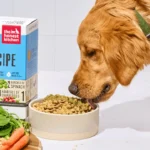[1] A healthy gut keeps a dog active and bright. When the stomach works well, it helps the dog absorb food, stay strong, and live with energy. Many dog owners use probiotics to support digestion. They keep the gut in balance and help the body stay clean from the inside.
Adding probiotics for dogs to meals can help reduce stomach problems and improve skin. It can also make your pet feel lighter and more cheerful. Still, you must add them in a safe way to avoid stomach upset. This article explains how to give probiotics safely, what type suits your dog, and how to check if they are helping.
Picking the Right Probiotic Type
Dogs need probiotics made for them. Human products may harm your pet because they have ingredients that are unsafe. Probiotics are available in different forms.
- Powder: Easy to mix with wet food.
- Chews or tablets: Work well for dogs that dislike powder.
- Natural foods: Some plain yogurt or fermented vegetables can help, but not every type is safe.
Before buying any probiotic, ask your vet. They can suggest the right kind based on your dog’s age, weight, and condition. This step helps you avoid side effects and makes sure the supplement works well.
How to Introduce Probiotics Slowly
Dogs need time to adjust to new food. Begin with a small dose and observe your dog’s response. If the stool looks soft or your dog seems uneasy, cut down the dose. Once the body adjusts, you can give the full amount. A slow start helps the stomach settle without stress. Give probiotics at a fixed time each day so your dog’s body can adjust to them. Stay regular with feeding because consistency helps the probiotics work better.
Add Probiotics to Meals
You can mix probiotics easily into your dog’s meal. Powder works best with wet food because it blends smoothly. For dry food, use a spoonful of broth so the powder sticks well. Do not heat food after adding probiotics. Heat kills live bacteria that support digestion. If you use probiotic treats, check that they are safe for dogs and feed them in small portions. Give the supplement during breakfast or dinner since the gut stays active after meals. After a few weeks, your dog may have better digestion, a stronger appetite, and more energy.
Signs That Probiotics Are Helping
A healthy dog shows clear signs once probiotics start working. The stool becomes firm and easy to clean. Gas or bloating reduces, and the dog looks more relaxed. You may notice brighter eyes or a shinier coat. Every dog reacts at a different pace. Some show change within days, others take more time. Keep watching for progress. If stomach problems stay the same, visit your vet for advice. They may suggest another probiotic or a smaller dose.
Probiotics with a Nutritious Diet
Food plays a key role in your dog’s gut health. Probiotics work better when your dog eats clean food. Add fiber-rich options like oats or sweet potatoes to help good bacteria grow. Stay away from processed snacks or leftovers from your plate. These foods can harm gut balance and make probiotics less useful.
A simple diet helps the gut recover faster. Give clean water daily and make sure your dog gets enough exercise. Adding probiotics for dogs to a diet that includes real food and proper care can make your pet healthier from the inside out. A balanced gut brings more energy, cleaner skin, and smoother digestion.
Common Mistakes to Avoid
Giving probiotics is simple, but small errors can reduce their effect. Here are some things to avoid:
- Using human probiotics
- Storing the product in a warm place
- Giving too much at one time
- Skipping doses
Follow the directions on the product label. Keep the container sealed in a cool, dry place. These small steps help keep the bacteria alive so your dog gets the full benefit. Mistakes can lead to wasted effort or stomach issues.
Keep Track of Progress
Once probiotics become part of your dog’s daily life, stay patient. Results take time. You may not see big changes in the first week, but steady progress is what matters. Pay attention to how your dog eats, sleeps, and moves. A better mood or higher energy means the gut is healing. Continue the same routine once it starts to work. Sudden changes in food or supplements can confuse your dog’s stomach.
Probiotics can improve your dog’s digestion and energy while building a stronger immune system. A healthy stomach helps your pet feel lighter and stay playful. Choose the right probiotic, start slowly, and keep meals clean. A simple routine like this can make a big difference in your dog’s comfort and health for a long time.






